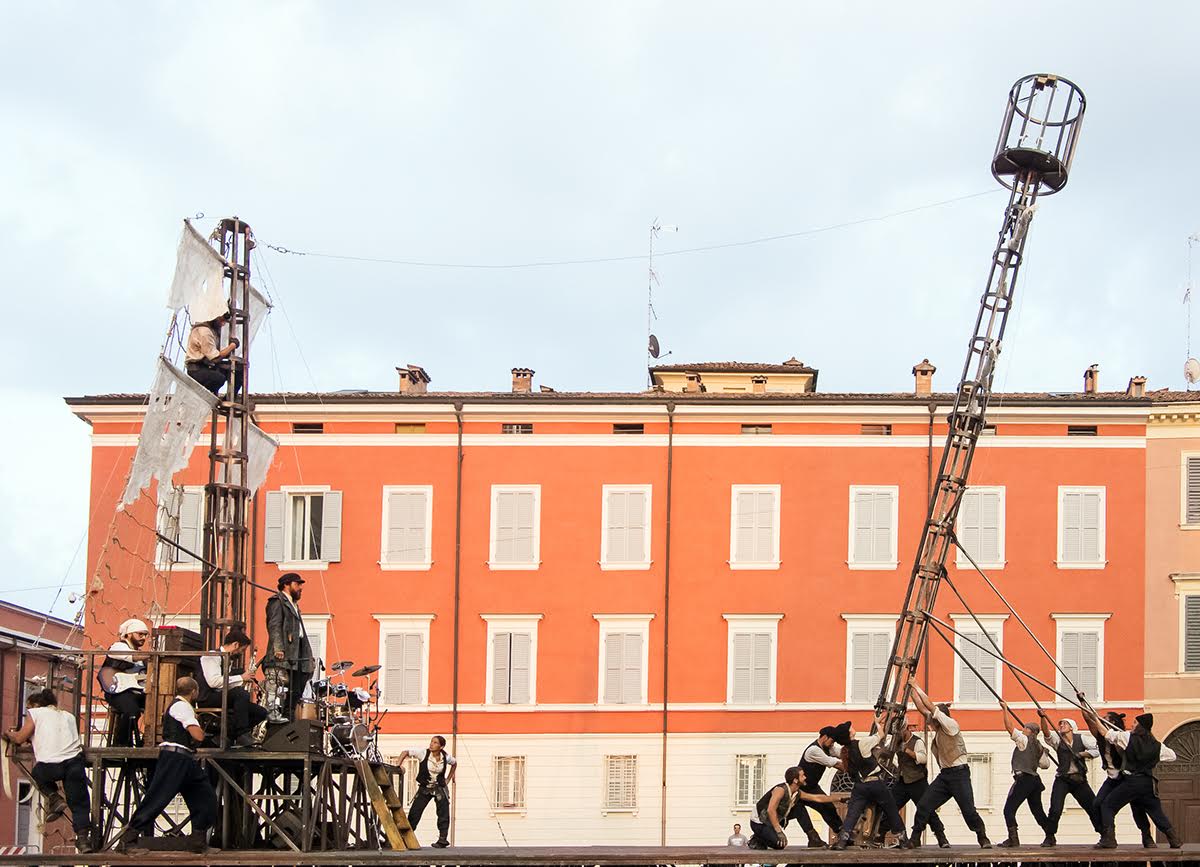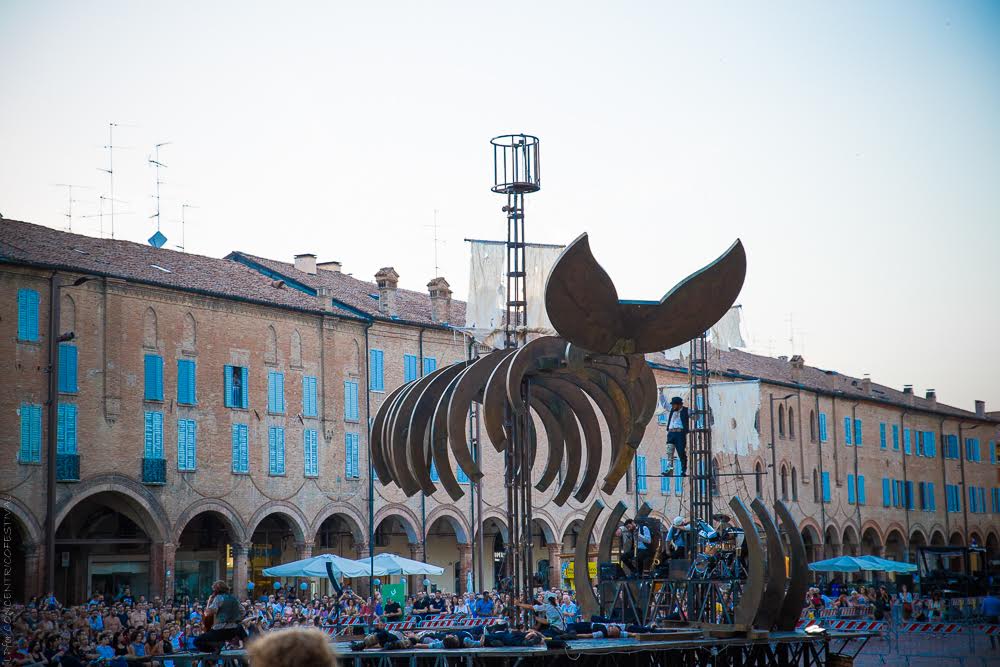
Street show of Teatro dei Venti
This performance-event is devised for urban settings, staging Captain Ahab’s ship and his obsession to find the White Whale, with huge theatrical machine and a company of 25 artists, including actors, musicians, acrobats and technicians. Teatro dei Venti continues in its artistic research in urban settings with a street performance that connects with the community and with the themes of a classic in world literature. The epic and nautical setting for Melville’s novel meets with the archaic sound of traditional barrels from Campania, in a work comprising philosophical reflections about the unknown, the contamination between languages from the East and West, and the use of huge theatrical machines.

photo by Chiara Ferrin
Moby Dick is, as writer Cesare Pavese wrote in the introduction to the novel with his translation, “the allegory of the spasmodic pursuit, of a thirst for knowledge and for revenge, of the relationship between good and evil, of the ferociousness and of the devastating force of nature and of man”.
A special project for communities
The show has a fixed core group of actors, dancers, acrobats, musicians and technicians. This nucleus of 20
artists can integrate members of the local community or artists suggested by the hosting venue (children, seniors,
local musicians, members of various associations, prisoners, asylum seekers, etc.)
When the community participates, seminars can be organised around the show or as a series distributed over a longer period. Obviously, this is a possibility and not a necessity.
The show is complete as it is, even without this project for local communities.The show has a fixed core group of actors, dancers, acrobats, musicians and technicians. This nucleus of 20
artists can integrate members of the local community or artists suggested by the hosting venue (children, seniors,
local musicians, members of various associations, prisoners, asylum seekers, etc.)
When the community participates, seminars can be organised around the show or as a series distributed over a longer period. Obviously, this is a possibility and not a necessity.
The show is complete as it is, even without this project for local communities.
Director’s notes
The square is empty, hanging, holding its breath. A deep, ancestral voice resounds from afar: twenty sailors, twenty men, twenty souls beat large wooden casks on a moving wagon; the barrels are empty, booming greedily,
waiting for the sperm whale oil. That sound rips the air and quivers. Its rhythm marks the work of the crew. Once reached the square, the wagon plows up the pavement. The music grows.
The audience watch the arrival of the wagon, which soon becomes a stage and turns into a frenzied shipyard. Plank by plank, lanyards, lines and tackles, the sailors start building the ship. Gaunt, bleak and unreal. It is our Pequod.
Throughout the show there will be struggles, sudden storms, and joyful raids; characters will emerge, stories will
surface. Meanwhile, Captain Ahab’s shadow and his dark thirst for revenge weigh heavily on everyone like a dreadful yet
enthralling nightmare.
Through a meticulous work of mechanical engineering the unexpected will happen: the ship becomes the whale.
From mother to monster. What first welcomed now shakes up: the skeleton of the hull capsizes and turns into the fearsome leviathan.
The two enemies will eventually come face to face for the final battle: Ahab and the White Whale.Man against Nature, the marvel, the unknown, the lost god, the fear that screams from the abyss: Moby Dick.

photo by Lara Parmiggiani
Concept and direction Stefano Tè; literary adaptation for the stage play Giulio Sonno; direction consultancy Mario Barzaghi; direction assistance Simone Bevilacqua; musical direction Luca Cacciatore, Igino L. Caselgrandi and Domenico Pizzulo; costumes by Teatro dei Venti, Luca Degl’Antoni and Beatrice Pizzardo; lighting design Alessandro Pasqualini; sound Eugenio Nonato.
Stage set up concept Stefano Tè and Dino Serra; design and construction Dino Serra and Massimo Zanelli.
With Alessio Boni, Oksana Casolari, Marco Cupellari, Daniele De Blasis, Alfonso Domínguez Escribano, Federico Faggioni, Talita Ferri, Francesca Figini, Davide Filippi, Hannes Langanky, Alberto Martinez, Amalia Ruocco, Antonio Santangelo, Felix Pacome Tehe Bly, Mersia Valente, Elisa Vignolo.
A Teatro dei Venti production, in co-production with Klaipeda Sea Festival (Lithuania), realized with the support of the Emilia-Romagna Region, the Municipality of Modena, the Modena Foundation, with the contribution of the Municipality of Dolo (VE) in collaboration with the Echidna Association.


